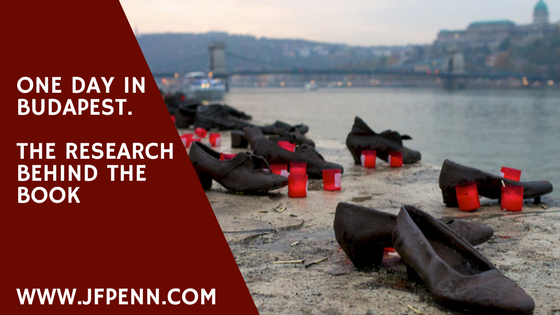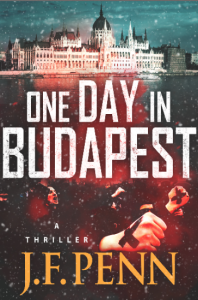 In November 2012, I visited Budapest with my husband for a research trip. The resulting novella, ‘One Day In Budapest' is now available on Amazon, Kobo and all ebook stores.
In November 2012, I visited Budapest with my husband for a research trip. The resulting novella, ‘One Day In Budapest' is now available on Amazon, Kobo and all ebook stores.
In the video below, I explain the inspiration for the story – both from the political angle as well as the historical. You can also view the video here on YouTube. Below the video is the description and the buy links.
 A relic, stolen from the heart of an ancient city.
A relic, stolen from the heart of an ancient city.
An echo of nationalist violence not seen since the dark days of the Second World War.
Budapest, Hungary. When a priest is murdered at the Basilica of St Stephen and the Holy Right relic is stolen, the ultra-nationalist Eröszak party calls for retribution and anti-Semitic violence erupts in the city.
Dr Morgan Sierra, psychologist and ARKANE agent, finds herself trapped inside the synagogue with Zoltan Fischer, a Hungarian Jewish security advisor. As the terrorism escalates, Morgan and Zoltan must race against time to find the Holy Right and expose the conspiracy, before blood is spilled again on the streets of Budapest.
One Day In Budapest is a chilling view of a possible future as Eastern Europe embraces right-wing nationalism. A conspiracy thriller for fans of Daniel Silva, where religion and politics intersect.
The novella features Dr Morgan Sierra from the ARKANE thrillers, but is stand-alone and can be read separately from the ARKANE series.
Sample or buy now in ebook, print and audio formats
Audiobook on Audible.com and on iTunes
Full transcript of the video
Hi, everyone, I’m thriller author J.F. Penn, and I’m here today to tell you a bit about my research process and the ideas behind “One Day in Budapest,” my novella, which is out now and available on all e-book platforms. And I promise there’ll be no spoilers, so don’t worry about that if you haven't read the book yet.
So, the story opens as Morgan Sierra is returning some items back to the synagogue, the Dohany Street Synagogue, which is the main one in Budapest. Now, these items were taken from the Gold Train which was a train, obviously, that was taken from the Nazis towards the end of the Second World War, so this is actually true, and I love to involve a lot of true stories in my books.
So, the Dohany Street Synagogue is one of the first places that I visited in Budapest, when I went there in November 2012, for partly a research trip, and also partly more of a personal trip. My husband is half-Hungarian, and also Jewish, so we were visiting the synagogue to have a look at his family history. So, it was a personal trip, it was also a deeply moving trip. And what you can see here is the gorgeous Dohany Street Synagogue, which is in the kind of Moorish style, beautiful architecture. And was kind of scary, this window, the rose window there you can see, is actually where Eichmann sat as they decided on who would go to the camps and who would stay in the ghetto, and this was where the Budapest Ghetto was. So, a kind of deeply disturbing historical area.
And the tree there, it’s a weeping willow tree in silver that is a memorial to the Jews killed in the Second World War, and behind there is actually a really amazing memorial to some of the Righteous Among Nations, who were the non-Jews who helped the Jews during that time.
So the Jewish history in Budapest is, is pretty sad, and you can see here a list of names, and the graveyard there–which is actually within the synagogue grounds, very unusual–is a mass grave for those people who died within the Budapest Ghetto, and they are actually buried there, within the synagogue grounds. And this brought home in a much more detailed manner, I guess, the deaths of the Second World War. It’s very hard to imagine millions of people, but you can imagine the thousands that are within these mass graves.
So that was a really deeply moving experience, and also, that memorial there, the shoes you can see, is some shoes cast in metal on the banks of the Danube. And that’s called The Shoes on the Danube, Memorial, which is within the book–I won’t tell you how. But it is basically a memorial to the people who were killed, the Jews who were shot by the Arrow Cross fascist militia, again in the Second World War. And again, they were just shot–told to take their shoes off and then shot, and their bodies fell in the water.
So, obviously, this was not a happy trip as such. Going back into this kind of history is very emotional. And when I was there, I really wanted to tell a story somehow that would bring in this history and would talk about the history of Budapest and this community, as well as the other people who’ve suffered, which I’ll come to in a minute. So, it’s I guess a dark history in Hungary. But what’s kind of interesting is it’s not just the history, and this is where the ideas behind the book come in.
These are some screen prints from The Guardian, which is a newspaper in Britain. And this is 2012, some of the news around Hungary’s right-wing neo-nationalists. And, essentially, in November 2012, which was while I was in Budapest, one of the Hungarian politicians actually called for a register of Jews in the country. And it was just so stark a contrast to me, seeing this synagogue, and the graves, and hearing about what had happened in the 40s, and then hearing news that was essentially what was happening before all of that. And in my head it was just kind of, well, what if this could happen again. And this party could very well become the dominant party in Hungary. It’s not just Jews: in the same way as the fascists in the past, they also target Roma and other kinds of ‘undesirables’ in quotation marks.
So, really interesting, and shocking, that there is this kind of neo-nationalist, anti-Semitic feeling, amongst some people in Hungary–not just Hungary, of course, it’s a worldwide issue. But what I wanted to do with my book was to kind of imagine what could happen, if a party like this got into power: what would happen. And so that’s the kind of political angle. It is also a kind of religious angle, but this is essentially political.
So that was the basis for the story, and then, as I’m a travel junkie, I really love to involve amazing places and interesting bits of history in my books. And here’s some pictures here of the Basilica of St Stephen, or St Istvan, as he’s known in Hungary. And you can just see in that picture of the shrine there, that is called the Holy Right. Amazingly interesting: this is the actually the holy right hand of St Stephen.
Now, the, the story goes that in, in around 1000A.D., St Stephen was the king of the Hungarian Empire at the time, and he was dying without an heir to the throne. And he called to the Virgin Mary, lifted his right hand and said, “Holy Virgin, look after the nation, become Queen of Hungary and look after them for me,” and then he died. But his right hand–this is over 1000 years old–this mummified fist, cut off at the wrist, it’s really, really cool, is there in the Basilica. And again, in the opening scenes of “One Day in Budapest,” you will see what happens with the Holy Right. But I love, relics, I think they’re fascinating, and the church is, is beautiful, so highly recommend a visit there.
Again, a very important place in Budapest, and quite stunning, because Budapest is really kind of showing this dark history, there’s a museum now, it’s called the House of Terror, and they’ve even got the big word ‘Terror’ over the house, it’s quite amazing. But inside, this is the tank inside, and a wall with all the victims. This building, 60 Andrassy Way, was actually the headquarters of the fascist Arrow Cross and the Fascist Party, as well as, then, the Communist Party, and some of the other awful things that happened to Hungary in, in the 50s.
So what was so amazing to me, or so distressing, I guess, was how many layers of suffering there have been in Hungary, in even the last 100 years. It’s a fascinating history to look at, and we think, “Ohthis is historical, this could never happen again,” and that’s why I wanted to write this story. But really, this House of Terror was fascinating. It’s been, sort of recreated and kept in the same way, and you can actually go into the rooms with all the records and a fascinating place to learn about what was happening there.
And then, of course, you have to bring in Castle Hill: that’s a, a view from Castle Hill over to the Parliament, at night, obviously. And that bird there is actually on the castle itself. It’s called a Turul–I’ve probably butchered the pronunciation, but the Turul is this magical bird from Hungarian myth. It represents power and strength. You might think it’s an eagle, but it’s actually a Turul, and it comes from the Magyar history and it can fly between the different worlds. And I wanted to bring in this sort of Magyar myth, it’s really fascinating. So I bring in a bit of shamanism and other things there.
And under Castle Hill is actually a cave system and tunnels, and a labyrinth, which unfortunately was closed to tourists, but I was able to research a lot of that on the Net with videos and pictures and things. So you’ll see how I bring that into the story. But, essentially, the, the whole city of Budapest has got these layers of, of intrigue and historical facts and just a fantastic place. So I wanted to really bring the city alive in the book, as well as try and talk a bit about the kind of political possibilities of the political future.
OK, so that is “One Day in Budapest,” a thriller novella, now available in e-book format everywhere. And you can also check out the ARKANE series, which is in print, audio and e-book. You can also check out my website at www.jfpenn.com, and I have a list, and you can get giveaways and all kinds of things, so yeah, come and check me out.
Thank you, I am thriller author J.F. Penn.

